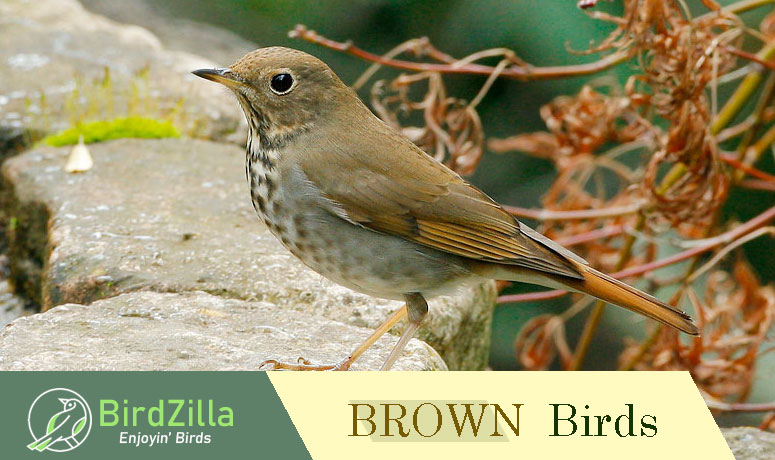
Brown birds lack flashy colors, but their beauty is shown in other, more subtle ways. Take a closer look at a bird with brown plumage and we can find intricate patterns created by combinations of buff and black spots, streaks, and other markings. There are usually hints of gray and at least a dozen shades of “brown”.
The soft hues known as “russet,” “rufous,” and “bay” help camouflage birds in woodlands, on nests, and in old autumn fields naturally painted with ragweed, cattails, and other tall vegetation.
Since brown is such a useful color in nature, it’s no wonder we see it in many common birds. See and learn about the most common brown birds below.
On this page
#15 Little Bunting
The Little Bunting is a very small, sparrow-like brown bird with a chestnut cap with a thick black border, a narrow white eyering on a chestnut face with a bit of a black border, and a forked tail with white outer tail feathers.
It can be recognized by these features and also has gray on the side of the neck, gray-brown upperparts streaked with black and buff, gray-brown wings with two white wing bars and buff edging, and white underparts with small black streaks on the side of the throat, breast, and flanks. Female and young birds look like the male but are duller.
The Little Bunting breeds in Northern Scandinavia and Russia, and is a rare vagrant to Alaska, and the Pacific coast of North America.
#14 Brown Jay
The Brown Jay is a big, long-tailed bird that is dark brown on the head, breast, and upperparts. The rest of the underparts are dingy white, and it has white on the underside of the tail.
This magpie-sized jay can be recognized by these features, has a stout black bill, and rather long, dark gray legs. The sexes are similar but young birds have a yellow eyering and yellow on the bill.
The Brown Jay mostly lives in tropical forest habitats in Mexico and Central America but small numbers also rarely occur in tropical scrub habitats in southern Texas.
#13 Brown Shrike
The Brown Shrike is large-headed bird with plain brown upperparts that are more reddish-brown on the cap, rump, and tail. Around the same size as a Red-winged Blackbird, it also has a stout, hooked bill, and a narrow black mask with a white border.
The Brown Shrike can be recognized by these features and also has buff edging on dark wings, a white throat, and pale or buff underparts. The sexes look similar but the female is paler and has faint scaling on the underparts.
They mainly feed on insects, but even eat small lizards and birds.
This species is native to edge and open woodland habitats in eastern and southern Asia and occurs as a rare visitor in Alaska and the Pacific coast of North America.
#12 Canyon Towhee
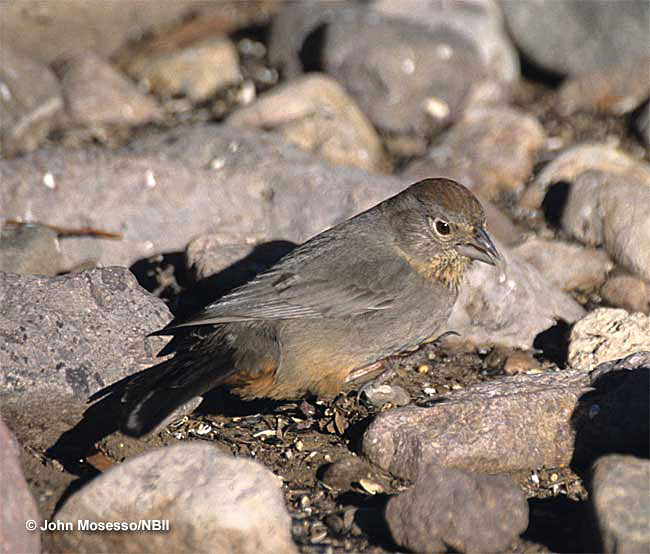
The Canyon Towhee is a fair-sized, plain, sparrow with brown highlights and gray upperparts. It has a dull brown cap, gray and buff throat with some small dark spotting, and has reddish-brown under the tail and on the lower belly.
Both sexes can be recognized by these features and also have pink-gray legs, and a finch-like, grayish bill. The Canyon Towhee is a common and conspicuous bird in a variety of arid scrubby habitats and pine-oak forest in southern Colorado, Arizona, New Mexico, western and central Texas, and northern and central Mexico.
#11 Veery
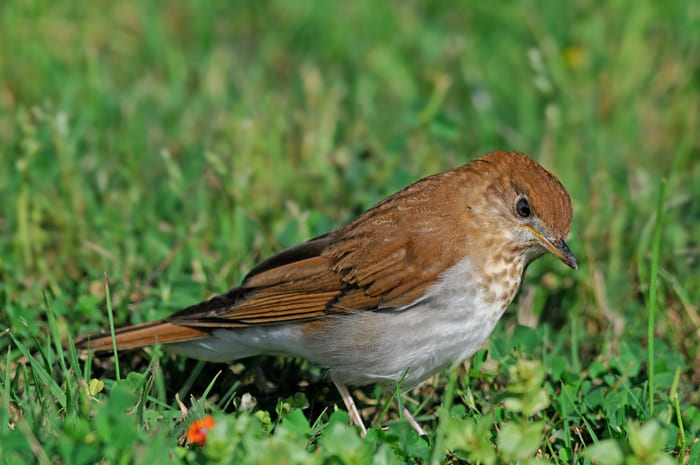
The Veery is a rather small thrush with reddish-brown upperparts, pale gray underparts with some faint reddish-brown spotting on the breast, a plain face with gray in front of the eye, and a narrow gray eyering.
Both sexes can be recognized by these features and also have pinkish legs and dark gray on the upper part and tip of a pinkish bill.
The Veery is a common bird that breeds near streams, marshes, and other wet habitats within deciduous forest and second growth in southern Canada, the northern Rocky Mountains, parts of the northern USA, and in the Appalachians.
They feed on a variety of insects, including grasshoppers, ants, caterpillars, spiders, and beetles, along with berries and fruit.
In parts of their range, they can be confused with the Wood Thrush. It migrates through the central and eastern USA to winter in Brazil and Bolivia.
#10 Hermit Thrush
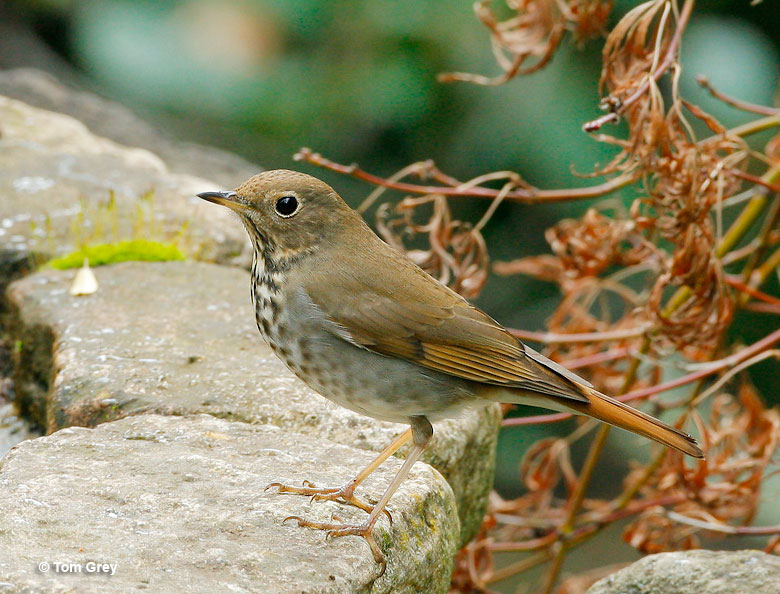
The Hermit Thrush is a rather small thrush with olive-brown upperparts, a reddish-brown rump and tail, a narrow, pale eyering, and small dark brown spots on a white breast.
Both sexes can be recognized by these features and also have reddish-brown highlights in the wings, dark brown markings on the side of the throat, pale brown on the lower flanks, pinkish legs, and a dark bill with a pale base.
They feed on insects and a variety of berries.
The Hermit Thrush breeds in coniferous and mixed forests in Canada, the northern USA, and in much of the Rocky Mountain region. It winters in wooded habitats in the Pacific coastal region, the eastern and southern USA, and Mexico.
#9 Swainson’s Thrush
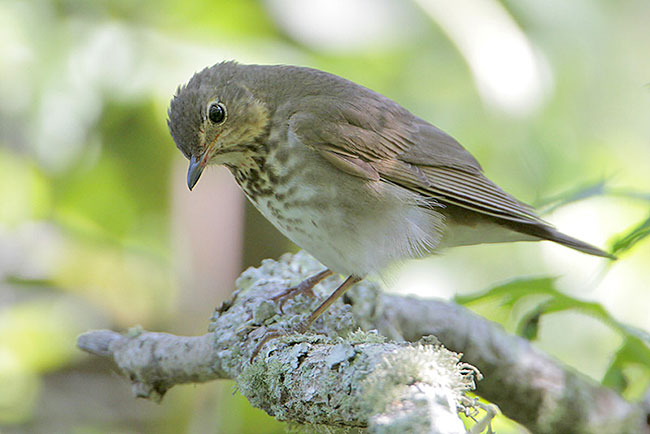
The Swainson’s Thrush is a rather small thrush with olive and russet highlights on earth-brown upperparts. Males and females look the same and can be recognized by their prominent buff eyering, and dark brown spots on a pale buff breast.
It also has some buff in front of the eye, the rest of the underparts are white with some dark brown spotting, and it has some brown on the sides of the lower belly. This thrush species also has a dark bill with a pale base, and pinkish legs.
The Swainson’s Thrush is a common small songbird that breeds in boreal and coniferous forests in Canada, the Rocky Mountains, some parts of the northern USA, and from Washington to southern California. Many also migrate throughout the USA.
#8 Barred Owl
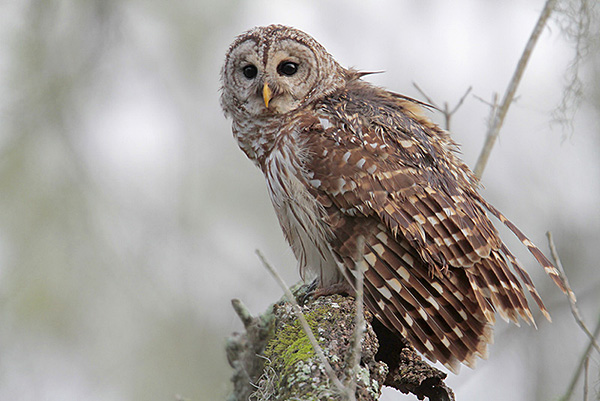
Photograph © Greg Lavaty.
The Barred Owl is a large owl that can be recognized by its rounded head lacking ear tufts or “horns”, pale face with dark brown border, and dark eyes. It also has dark brown upperparts with small white and buff streaks and markings, and a rectangular, dark brown tail with pale buff bands.
Barred Owls have white underparts with dark brown barring on the throat and breast, and dark brown streaks on the rest of the underparts. It also has a yellow-orange bill. The Barred Owl is a common bird of forest habitats in southern Canada, the Pacific Northwest to northern California, and the eastern USA. Both sexes look the same but females are bigger.
#7 Skylark
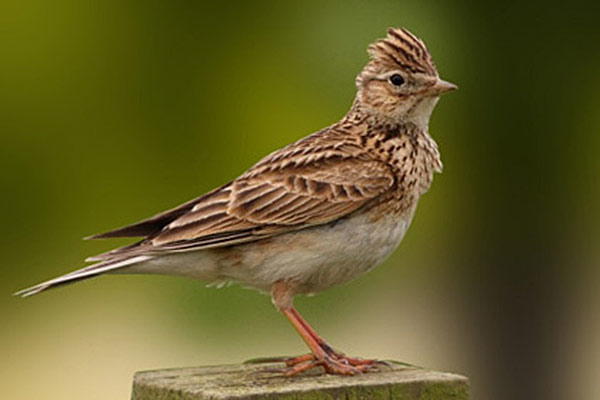
The Skylark is a rather plump, crested, long-winged songbird a bit smaller than a Starling. It can be recognized by its crest, gray-brown upperparts with dark streaks, and gray-brown tail with white in the outer feathers.
It also has a large, pale-brown patch on the face bordered with white, and some buff on the breast and flanks. The rest of the underparts are white with small dark streaks on the breast and flanks.
This species is native to Europe east to Russia and Japan but was introduced to Hawaii, New Zealand, and Vancouver Island. Both sexes look similar and live in grasslands, big meadows, and extensive, open farmlands.
#6 Brown Creeper

The Brown Creeper is a small bird with a slightly curved, sharp, dark bill, a pale eyebrow, dark brown upperparts with white and buff markings, and white underparts. Male and female birds are similar, have tan on the rump and tail, and buff under the tail and on the belly.
In North America, the Brown Creeper is the only small brown bird that hitches up tree trunks. During summer, it lives in forests in southern Alaska, Canada, around The Great Lakes, in the western and northeastern states, in the Appalachians, and mountains from Mexico to Nicaragua.
In the winter, it also occurs in parks and other woodlands in southern Canada and much of the lower 48 states.
#5 Cactus Wren
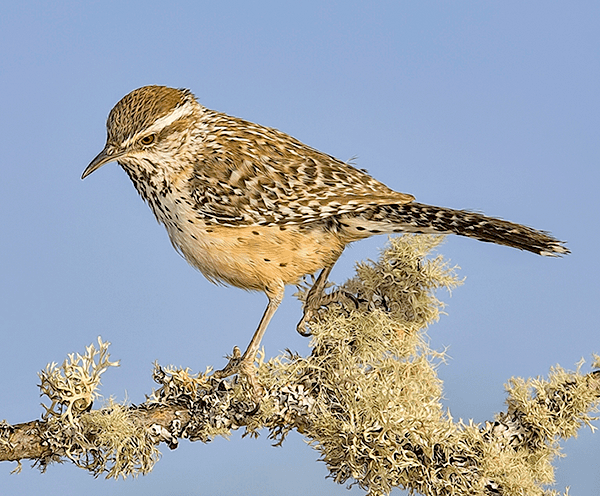
Photograph © Alan Wilson.
Cactus Wren is a fairly large, long-tailed bird with a sharp, slightly curved bill. Males and females are similar and have gray-brown on the back, a dark brown cap, a thick black and dark brown line behind the eye, and tan on the belly.
This bold and noisy bird can also be recognized by the white eyebrow, white and black mottling on the face, black on the throat and breast, black spotting on the underparts, white and dark streaks and marks on the wings and back, and a gray tail with black and white markings.
The Cactus Wren is common in desert habitats of the American southwest, central and western Texas, and northern Mexico.
#4 Brown Thrasher
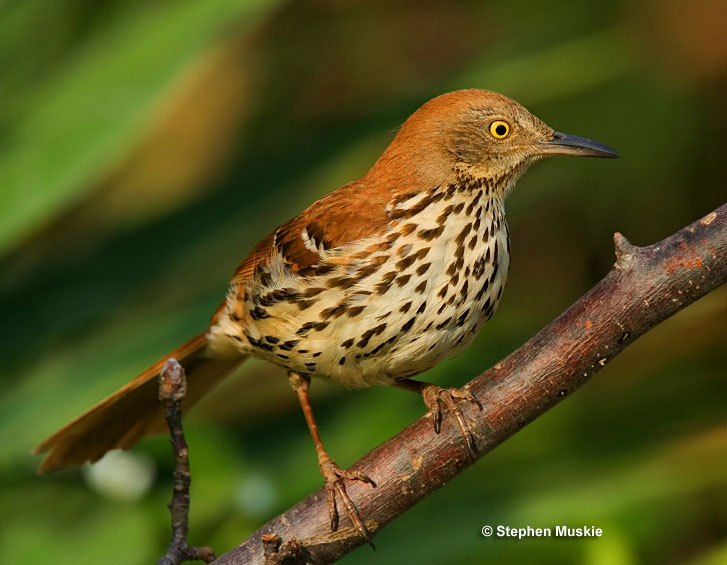
The Brown Thrasher is a large member of the mockingbird family, living east of the Rocky Mountains in southern Canada and much of the eastern USA.
Both sexes of this distinctive bird look similar and can be recognized by the long, reddish-brown tail, brown heads, pale orange eye, two short white wing bars, and pale underparts with dark streaks on the breast and flanks. The upperparts are rufous-brown with pale gray mottling on the face.
It also has long, pinkish legs used for hopping and foraging on the ground in parks, near second growth, and in open woodlands. These thrashers can also be spotted in backyards, but they are not too interested in bird feeders.
#3 House Wren
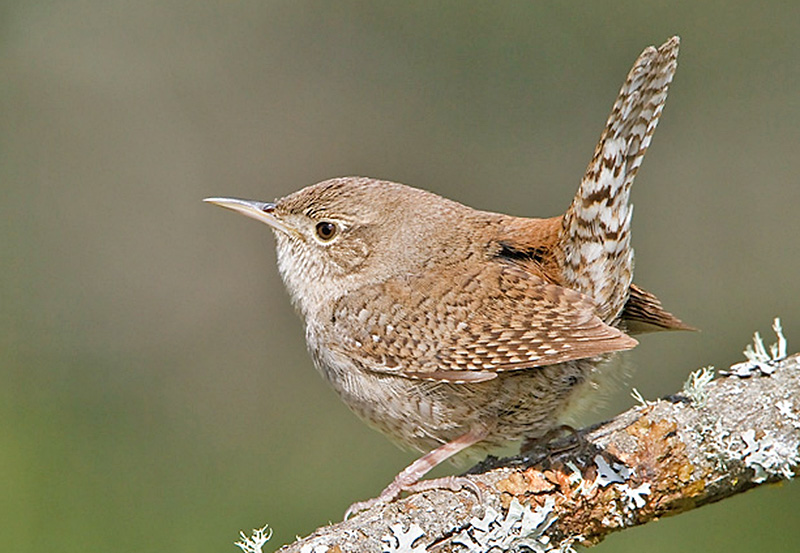
Photograph © Glenn Bartley.
House Wren is a small, cheerful bird entirely plumaged in different shades of brown. Both sexes can be recognized by their plain brown plumage, longish, frequently cocked tail, and sharp bill. It has gray highlights on the head, throat, and under the tail, and small black markings on the short, rounded wings, tail, and undertail.
True to its name, the House Wren is often found near homes with large gardens, and is very common in parks and open woodlands with cavities for nesting.
House Wrens have interesting nesting habits, where the male builds several nests, that are often incomplete. The female chooses one and finishes the building process to lay her eg
It occurs in southern Canada and the United States.
#2 Cedar Waxwing
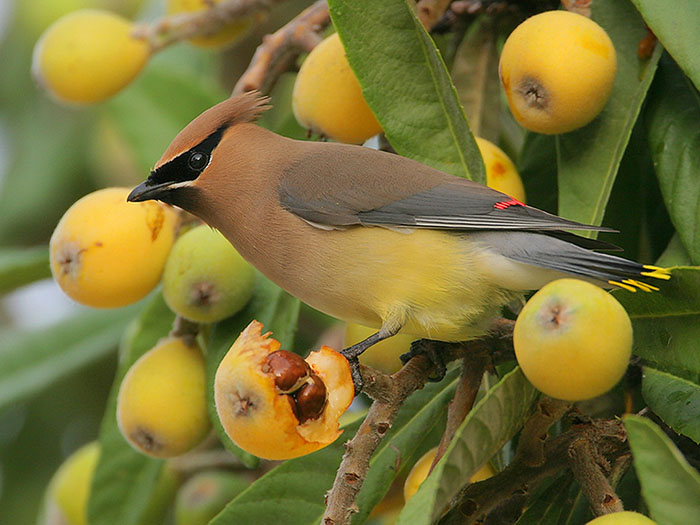
Cedar Waxwing is a sleek, long-winged bird easily recognized by its crest, narrow black mask partially bordered with white, and a yellow tip on its dark, blue- gray tail.
The rest of its head, breast, sides, and back have soft brown hues, the belly is pale yellow, and the lower back and rump are slate-gray. The wings are also gray and black with some white edging and a few tiny, waxy red dots. Both sexes of this common bird look the same and move around in flocks to feed on berries in parks, woodlands, and other wooded habitats.
These flycatchers are found in the southern half of Canada and throughout the lower 48 states.
#1 House Sparrow
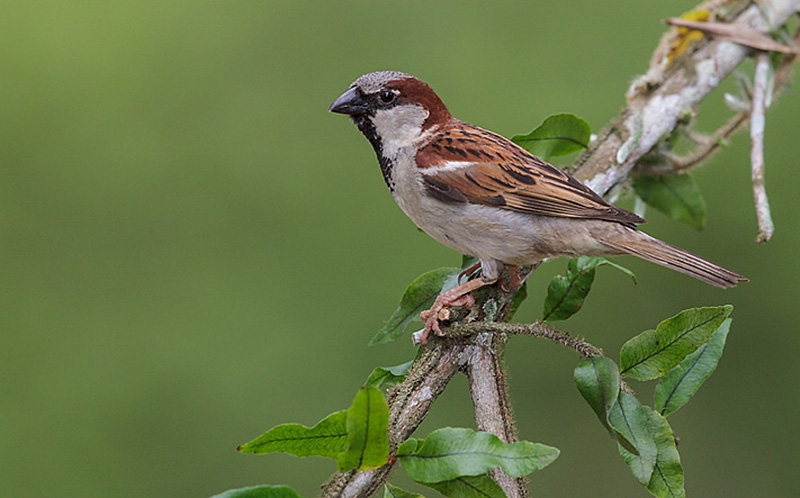
House Sparrow (Passer domesticus) perched on a branch in the Atlantic rainforest of southeast Brazil.
The House Sparrow is a small, familiar bird with a deep, finch-like bill, and gray and brown plumage. The male can be recognized by the black on the throat, around the eye, and on the bill.
The rest of the head is chestnut and gray, and it has a brown back, wings with some dark and buff streaks, and two narrow white wing bars.
Female House Sparrow is like the male but is plain, and can be recognized by the yellowish lower part of the beak, gray throat and face with a brown cap and a buff mark behind the eye.
They can be confused with the American Tree Sparrow, Song Sparrows, and Chipping Sparrows, although their habitats are not always so similar.
These common birds are often seen in gardens, urban areas, and farmlands. At feeders, they really like seeds, such as sunflower seeds and thistle seeds. They aren’t too fond of suet feeders.
House Sparrows are incredibly common, inhabiting North and South America, Europe, Asia, Australia, and Asia.


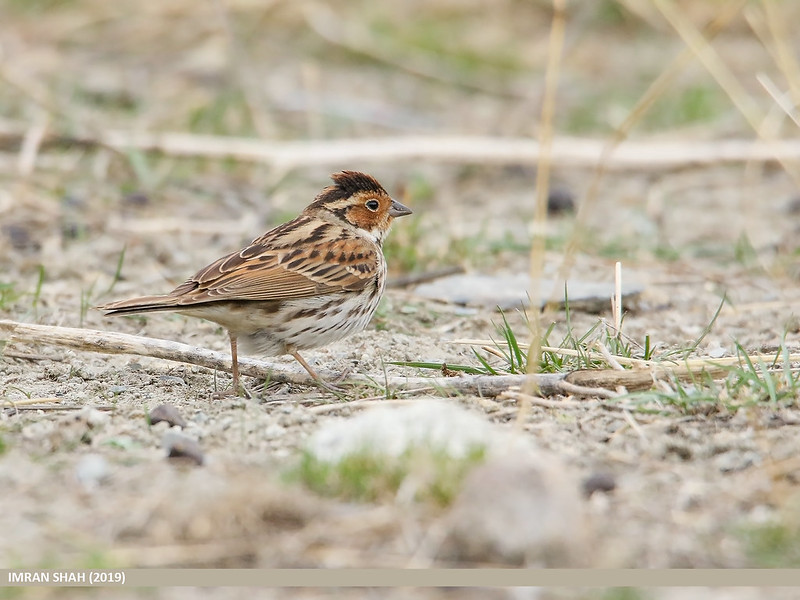
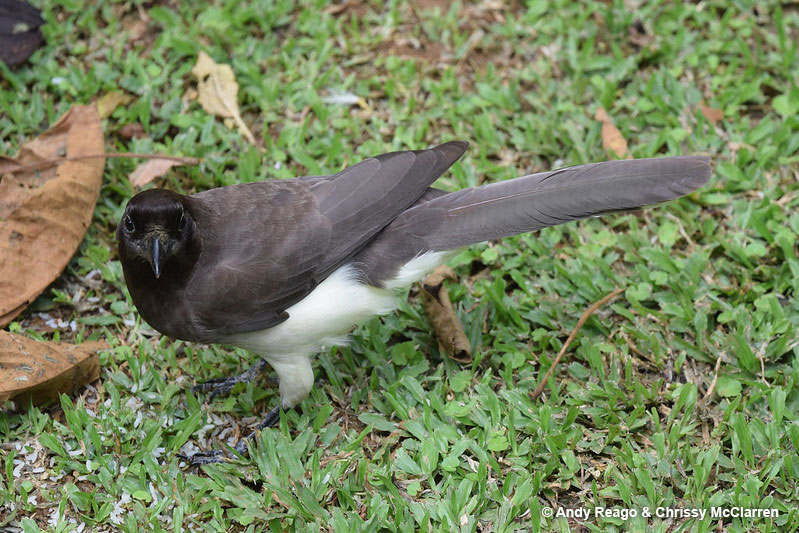
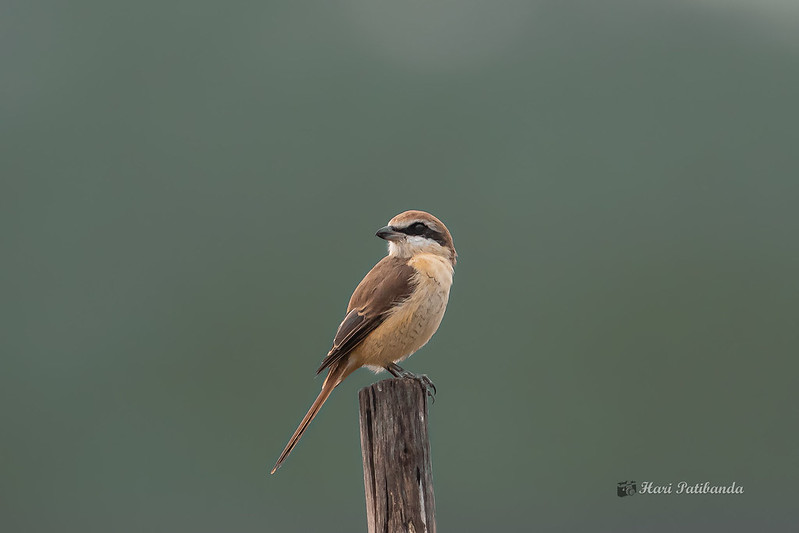
Dale L. Hurd
Sunday 3rd of March 2024
I was sitting down. All of the sudden. A small completely chocolate colored bird landed in front of me.Stood there for about 10 to 15 seconds. Then flew away as fast as it landed. It had only very dark brown coloring. It's whole body was that color. It appeared to be about 2 to 2.5 inches long. A small sharp pointed beck. About 1.75 to 2.00 inches tall.
I have much better things to Dothan to make tings up.
My only concern. Is that someone can identify this bird.
Sincerely,
Dale Lincoln Hurd
Patrick O'Donnell
Monday 4th of March 2024
@Dale- Thanks for sharing your report. I wonder if it might have been a House Wren, or maybe a Winter Wren? Although it could be another species, those birds sort of fit that description.
Where did you see it (which state or province)? Is there forest nearby, scattered trees and bushes, or is it a residential area?